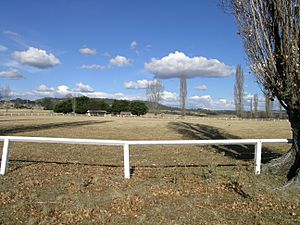Stonehenge, New South Wales facts for kids
Stonehenge is a small country area in New South Wales, Australia. It is located on the Northern Tablelands, which is a high, flat area in the region of New England.
Stonehenge is about 8 kilometers (5 miles) south of a town called Glen Innes. It sits along the New England Highway, a main road, and is just north of a waterway known as Beardy Waters. This area is quite high up, about 1,067 meters (3,500 feet) above sea level. The land here is mostly flat but is covered with many large granite rocks. Some of these rocks are over 5 meters (16 feet) tall! One special rock is a round stone about 2.5 meters (8 feet) wide, known as the Balancing Rock. The area was named Stonehenge because these local rock formations reminded people of the famous Stonehenge in England.
Contents
A Look at Stonehenge's Past
First People of Stonehenge
The land where Stonehenge is located today originally belonged to the Ngarabal people. They called this area "Hol'pin," which means "many casuarinas near a large plain." The Ngarabal people still consider this area very important, as it holds many sacred sites and historical remains.
Early European Settlement
In 1838, a large property called Stonehenge Station was started by Thomas Hewitt for Archibald Boyd. This made him one of the first European settlers in the Glen Innes area. By 1848, Stonehenge, also known as Boyd’s Plains, was a huge property covering about 32,375 hectares (80,000 acres). Later, in 1886, a farmer from Queensland named George Morris Simpson bought the station. He built the main house, called the homestead, the very next year.
The Railway Connection
The Main North railway line used to cross the New England Highway right at Stonehenge. There was even a railway station there! It opened in 1884, making it easier for people and goods to travel. However, the station closed around 1974, and the railway line is no longer in use.
Fun and Recreation
Stonehenge has a special area called a recreation reserve. It's about 32 hectares (80 acres) in size. This reserve includes a sports ground where people can play, a shelter shed, and toilets. It's a place for the community to gather and enjoy outdoor activities.
Local News
If you want to know what's happening in Stonehenge and the surrounding areas, you can check out the Glen Innes News. This local newspaper shares news both in print and online.


